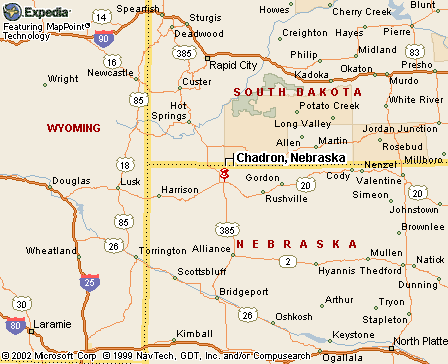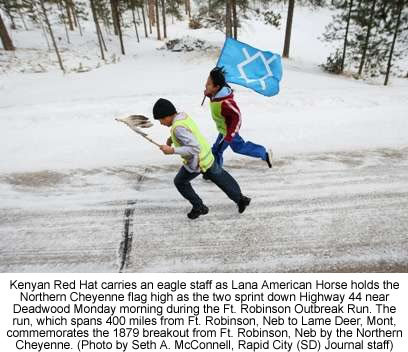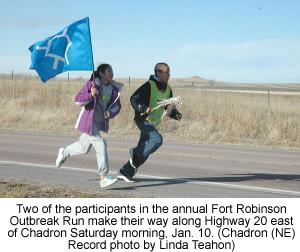 |
Canku Ota
|
 |
|
(Many Paths)
|
||
|
An Online Newsletter
Celebrating Native America
|
||
|
February 1, 2009 - Volume
7 Number 2
|
||
|
|
||
|
Runners Pay Tribute
To Ancestors
|
||
|
by Jomay Steen, Rapid
City Journal
|
||
|
They are with a group of Native American youth on the Fort Robinson Outbreak Spiritual Run. It’s a 400-mile journey from Fort Robinson, Neb., through the Black Hills, to Busby, Mont. The 10th annual event commemorates what some of their ancestors did in defying government troops to survive 130 years ago. It’s the second time that the three have made the run, which started Friday night at the historic cavalry outpost and is scheduled to end Wednesday. To join them and about 130 others, Johnny Big Medicine, 18, had hitchhiked from Montana to reach the historic fort’s Comanche Hall on Friday morning.The Lame Deer High School student said he had felt a responsibility to the run’s organizers, Phillip Whiteman Jr. and Lynette Two Bulls, to take on running duties when weather conditions would be too much for younger runners. “We run when it’s too cold for the little ones,” he said of other older participants. He also felt it was something he should do for his family. “This is my fourth year running. My brother got into an accident, and I just wanted to come and run for him,” Big Medicine said. For themselves and their relatives, present and past, the boys from Lame Deer see the run as a time to remember their ancestors’ sacrifice, to relive a significant part of their tribe’s history and to test themselves. “I guess it’s fun. It is like being free from school, but it’s all about our culture,” Jonathan said of why he participates. “I try to think of my ancestors, and what they had survived,” Keynen said of his turn to run.
In relay style, runners position themselves along U.S. Highway 385 about 100 feet apart as runners sprinted along the shoulder of the road, passing off a staff to the next group of runners. A half-dozen vans and school bus carried the runners along the route, picking up the sprinters and dropping off the new runners along the route. Whiteman said that volunteers have helped with feeding the participants, fueling the vans and keeping the show on the road. The traveling group includes speakers who talk about their great-grandparents as part of the educational portion of the journey. Following the caravan are two Kansas historians documenting the journey. Jim Leiker, history professor of Johnson County Community College at Overland Park, Kan., and Ramon Powers, retired director of the Kansas State Historical Society, are documenting the run’s cultural history. Leiker said because of treaty terms negotiated between the U.S. government and the Sioux, the Northern Cheyenne had been sent to Indian Territory in Oklahoma. Two-thirds of the tribe decided to stay, but the rest wanted to return to their northern hunting grounds and resume their way of life. Either through misinformation by interpreters or outright lying by the government, the people of Dull Knife and Little Wolf believed they could return to Montana at any time. They set off, but soon the military was in pursuit, he said. In reaching Fort Robinson, Dull Knife’s group was ordered back to Oklahoma. Their stance was, “We’ll die before we go back,” Leiker said. Upon fleeing the barracks on Jan. 9, 1879, 63 Cheyenne were wounded or killed by soldiers. A few managed to escape to Pine Ridge, where they lived with Red Cloud’s people. An estimated 38 Cheyenne began the last leg of their flight to their Montana homeland and freedom. Little Wolf’s group successfully made it into the Montana, he said. Little Wolf and Dull Knife, who died in 1883, are buried at Lame Deer.
|
 Chadron, Nebraska map |
www.expedia.com |
|
|
||
|
|
||
| Canku Ota is a free Newsletter celebrating Native America, its traditions and accomplishments . We do not provide subscriber or visitor names to anyone. Some articles presented in Canku Ota may contain copyright material. We have received appropriate permissions for republishing any articles. Material appearing here is distributed without profit or monetary gain to those who have expressed an interest. This is in accordance with Title 17 U.S.C. Section 107. | ||
|
Canku Ota is a copyright ©
2000, 2001, 2002, 2003, 2004, 2005, 2006, 2007, 2008, 2009 of Vicki
Barry and Paul Barry.
|
||
 |
 |
|
|
The "Canku
Ota - A Newsletter Celebrating Native America" web site and
its design is the
|
||
|
Copyright ©
1999, 2000, 2001, 2002, 2003, 2004, 2005,
2006, 2007, 2008 of Paul C.
Barry.
|
||
|
All Rights Reserved.
|
||
 Considering
they are 11 years old, some might think that Jonathan American Horse,
Keynen Red Hat and Roy Fighting Bear see their current field trip
as a good way to get out of classes. It is, they say, for reasons
other than play.
Considering
they are 11 years old, some might think that Jonathan American Horse,
Keynen Red Hat and Roy Fighting Bear see their current field trip
as a good way to get out of classes. It is, they say, for reasons
other than play.  This
year’s runners, in keeping with the historic record, broke
out of the fort’s old barracks about 10:30 p.m. Friday into
the raw winter wind to run by moonlight for the first 15 miles.
This
year’s runners, in keeping with the historic record, broke
out of the fort’s old barracks about 10:30 p.m. Friday into
the raw winter wind to run by moonlight for the first 15 miles.